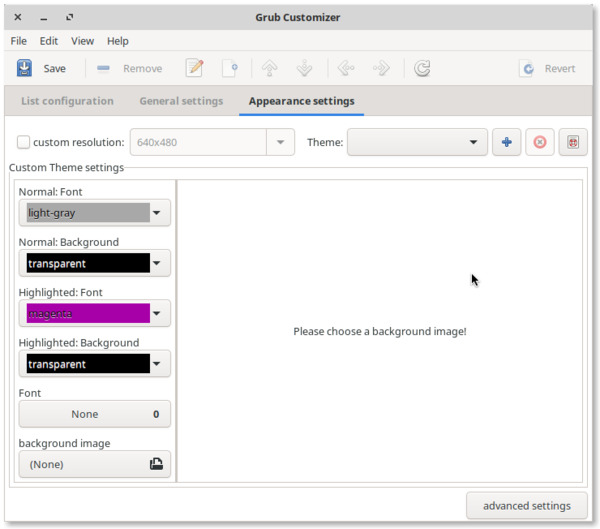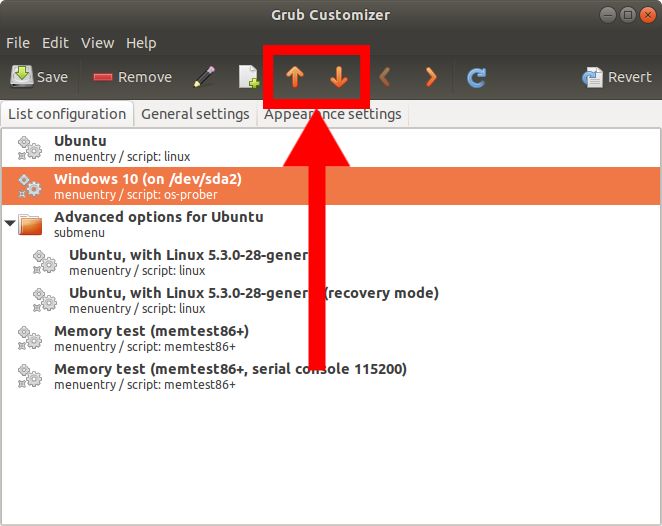

- GRUB CUSTOMIZER FOR WINDOWS 10 HOW TO
- GRUB CUSTOMIZER FOR WINDOWS 10 FULL VERSION
- GRUB CUSTOMIZER FOR WINDOWS 10 INSTALL
- GRUB CUSTOMIZER FOR WINDOWS 10 DRIVERS
Typically, it should be at least 1.5x or 2x the size of the amount of RAM installed on your computer. On “Size,” select the amount of space for the swap partition. Under “Use as,” use the drop-down menu and select Swap area to create a swap partition.
GRUB CUSTOMIZER FOR WINDOWS 10 DRIVERS
Ubuntu updates and drivers selection setupĭouble-click the free space, the unallocated space you created on Windows 10 (or right-click it and select Add).
GRUB CUSTOMIZER FOR WINDOWS 10 INSTALL
Using the keyboard, select your language, and press Enter to continue.Ĭheck the Download updates while installing Ubuntu option.Ĭheck the Install third-party software for graphics and Wi-Fi hardware, Flash, MP3 and other media option.

However, make sure to check your computer manufacturer support website for more details. Typically, you can change these settings by pressing one of the functions (e.g., F2, F8, F12), Delete, or ESC key. Quick Tip: If your PC is not starting into the Ubuntu setup, you may need to access the system BIOS to change the boot settings to start from USB.
GRUB CUSTOMIZER FOR WINDOWS 10 HOW TO
How to install Ubuntu alongside Windows 10 Select the Write in ISO Image mode option.Īfter completing the steps, you can proceed with the steps below to create a dual-boot system with Ubuntu and Windows 10. If you’re prompted to download additional files to create a bootable drive using a Linux distro, click Yes. On “Create a bootable disk using,” select ISO image, and click the drive icon. Under “Cluster size,” leave the default selection. Under “Partition scheme and target system type,” use the drop-down menu and select MBR partition scheme for BIOS or UEFI. On “Device,” use the drop-down menu and select the USB flash drive you want to use. On Windows 10, the easiest way to create a USB bootable drive with the Ubuntu files that will boot on BIOS or UEFI is using the Rufus tool.ĭouble-click the. You’ll also need to download the ISO file containing the latest version of Ubuntu, which you can use to create a bootable media. Once you’ve completed the steps, you’ll end up with a small partition for Windows 10 and some unallocated space that you can now use to install Ubuntu. (Ubuntu requires 5GB of available space for the installation, but it’s recommended to select at least 10GB or more.) Select the amount of space to shrink in megabytes. Right-click the (C:) partition, and select Shrink Volume. Search for Create and format hard disk partitions and click the result to open Disk Management. Warning: It’s important to note that even though it’s safe to use this process to install Ubuntu alongside Windows 10, it’s still recommended to create a full backup of your computer before proceeding in case you need to rollback. Instead, it’s recommended to shrink the Windows 10 partition to make room for the Ubuntu installation before proceeding and use the manual setup during install. How to shrink Windows 10 partition to install UbuntuĪlthough the Ubuntu setup includes an option to install alongside Windows 10, sometimes it may not work as expected.

GRUB CUSTOMIZER FOR WINDOWS 10 FULL VERSION
If you don’t have a spare computer to install a full version of Linux, you can alternatively modify your current installation to run Ubuntu alongside Windows 10 on a dual-boot setup. Although on Windows 10, you can now install different Linux distros, including Ubuntu, SUSE, and Fedora, sometimes you may be still required to use the full-blown version of Linux to access a particular tool that you need to get the work done.


 0 kommentar(er)
0 kommentar(er)
